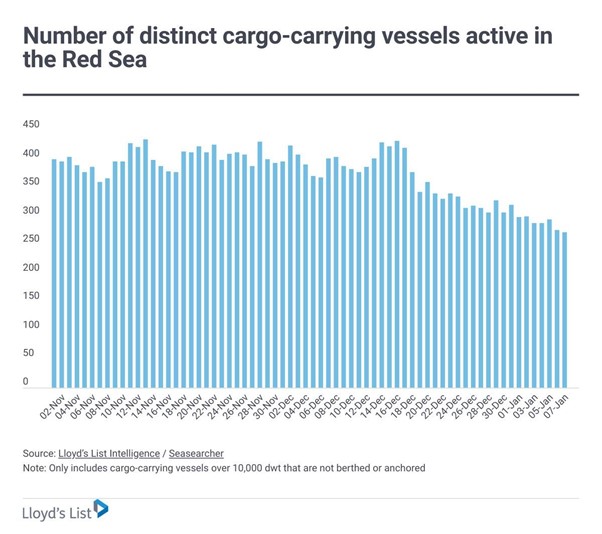The Red Sea is experiencing a notable shift in maritime activity, particularly in the average daily number of active vessels. Among the affected sectors, containerships, general cargo ships, and vehicle carriers stand out as they exhibit downward trends, marking a departure from both recent and historical patterns.
In response to the crisis, major container lines opted to suspend operations in the region, with vessels diverting to navigate around the Cape of Good Hope. According to Lloyd’s List Intelligence data, passes around the Cape increased by 27% in the final week of December compared to the previous week. This increase highlights a tangible impact on global shipping routes, necessitating a closer examination of the consequences of these route deviations.

Supply Chain Considerations:
As containerships divert from the Red Sea, questions arise regarding the broader impacts on supply chains. Stakeholders in the industry may need to reassess trade and shipping patterns in the Red Sea and the surrounding regions to ensure resilience and adaptability to evolving circumstances.
Trade Lane Recalibration:
The shift in maritime activity highlights the need for trade lane recalibration. As the crisis evolves, the status quo is disrupted leading to businesses requiring new bunkering facilities and adapting to emerging trends for sustained growth.
Leveraging Predictive Fleet Analytics:
Amid this disruption, it is vital to understand how shifting trade patterns could impact your business operations. Predictive Fleet Analytics provides comprehensive insights into current and historical trade flows, enabling you to make informed decisions in this dynamic market.
Trade Lanes Feature:
PFA's Trade Lanes feature empowers businesses with a comprehensive view of the global fleet. It allows for the analysis of traffic volumes and activities at ports, providing actionable insights for identifying real-time opportunities for expansion and market penetration.
Port Congestion Management:
As the risk of port congestion increases due to altered traffic patterns, PFA's Port Congestion feature becomes invaluable. It offers real-time updates on estimated time of arrival (ETA) at anchorage and estimated time to berth (ETB), ensuring smooth supply chain management and enhancing customer satisfaction.
In conclusion, the evolving maritime landscape as a result of the Red Sea crisis demands a proactive approach. By embracing PFA, businesses can not only understand the changing dynamics but also seize opportunities and effectively manage the challenges associated with the recalibration of trade lanes and the resultant impact on global shipping routes.